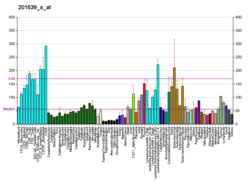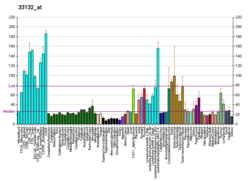Protein-coding gene in humans
| CPSF1 |
|---|
|
| Identifiers |
|---|
| Aliases | CPSF1, CPSF160, HSU37012, P/cl.18, cleavage and polyadenylation specific factor 1 |
|---|
| External IDs | OMIM: 606027; MGI: 2679722; HomoloGene: 40865; GeneCards: CPSF1; OMA:CPSF1 - orthologs |
|---|
| Gene location (Human) |
|---|
 | | Chr. | Chromosome 8 (human)[1] |
|---|
| | Band | 8q24.3 | Start | 144,393,229 bp[1] |
|---|
| End | 144,409,349 bp[1] |
|---|
|
| Gene location (Mouse) |
|---|
 | | Chr. | Chromosome 15 (mouse)[2] |
|---|
| | Band | 15|15 D3 | Start | 76,480,003 bp[2] |
|---|
| End | 76,491,791 bp[2] |
|---|
|
| RNA expression pattern |
|---|
| Bgee | | Human | Mouse (ortholog) |
|---|
| Top expressed in | - right testis
- left testis
- right hemisphere of cerebellum
- right uterine tube
- granulocyte
- pituitary gland
- anterior pituitary
- duodenum
- mucosa of transverse colon
- spleen
|
| | Top expressed in | - internal carotid artery
- external carotid artery
- hair follicle
- primitive streak
- vestibular membrane of cochlear duct
- endothelial cell of lymphatic vessel
- epiblast
- neural layer of retina
- ventricular zone
- adrenal gland
|
| | More reference expression data |
|
|---|
| BioGPS | 

 | | More reference expression data |
|
|---|
|
| Gene ontology |
|---|
| Molecular function | - nucleic acid binding
- enzyme binding
- protein binding
- mRNA 3'-UTR AU-rich region binding
- RNA binding
| | Cellular component | - mRNA cleavage and polyadenylation specificity factor complex
- nucleus
- nucleoplasm
| | Biological process | - mRNA splicing, via spliceosome
- termination of RNA polymerase II transcription
- mRNA polyadenylation
- mRNA processing
- mRNA cleavage
- mRNA 3'-end processing
- mRNA export from nucleus
- pre-mRNA cleavage required for polyadenylation
- tRNA splicing, via endonucleolytic cleavage and ligation
| | Sources:Amigo / QuickGO |
|
| Orthologs |
|---|
| Species | Human | Mouse |
|---|
| Entrez | | |
|---|
| Ensembl | | |
|---|
| UniProt | | |
|---|
| RefSeq (mRNA) | | |
|---|
NM_001164173
NM_053193
NM_001361485 |
|
|---|
| RefSeq (protein) | | |
|---|
NP_001157645
NP_444423
NP_001348414 |
|
|---|
| Location (UCSC) | Chr 8: 144.39 – 144.41 Mb | Chr 15: 76.48 – 76.49 Mb |
|---|
| PubMed search | [3] | [4] |
|---|
|
| Wikidata |
| View/Edit Human | View/Edit Mouse |
|
Cleavage and polyadenylation specificity factor subunit 1 is a protein that in humans is encoded by the CPSF1 gene.[5][6][7]
In most cases eukaryotic pre-messenger(m)RNA 3 prime ends are processed in two coordinated steps. First there is a site-specific cleavage by an endonuclease and then the addition of a poly(A) tail at the 3 prime end of the 5 prime cleavage product. Cleavage requires four multisubunit complexes, namely cleavage and polyadenylation specificity factor (CPSF), cleavage stimulation factor (CstF), cleavage factors Im and IIm (CFIm and CFIIm), along with a single subunit poly(A)polymerase (PAP). CPSF1 is the largest component of the CPSF complex composed of CPSF1, CPSF2, CPSF3, CPSF4, FIP1L1, Symplekin and WDR33 and located in the nucleus.[8]
References
- ^ a b c GRCh38: Ensembl release 89: ENSG00000071894 – Ensembl, May 2017
- ^ a b c GRCm38: Ensembl release 89: ENSMUSG00000034022 – Ensembl, May 2017
- ^ "Human PubMed Reference:". National Center for Biotechnology Information, U.S. National Library of Medicine.
- ^ "Mouse PubMed Reference:". National Center for Biotechnology Information, U.S. National Library of Medicine.
- ^ Jenny A, Keller W (Sep 1995). "Cloning of cDNAs encoding the 160 kDa subunit of the bovine cleavage and polyadenylation specificity factor". Nucleic Acids Res. 23 (14): 2629–35. doi:10.1093/nar/23.14.2629. PMC 307085. PMID 7651824.
- ^ Murthy KG, Manley JL (Dec 1995). "The 160-kD subunit of human cleavage-polyadenylation specificity factor coordinates pre-mRNA 3'-end formation". Genes Dev. 9 (21): 2672–83. doi:10.1101/gad.9.21.2672. PMID 7590244.
- ^ "Entrez Gene: CPSF1 cleavage and polyadenylation specific factor 1, 160kDa".
- ^ Shi Y, Di Giammartino DC, Taylor D, Sarkeshik A, Rice WJ, Yates JR, Frank J, Manley JL (February 2009). "Molecular architecture of the human pre-mRNA 3' processing complex". Mol. Cell. 33 (3): 365–76. doi:10.1016/j.molcel.2008.12.028. PMC 2946185. PMID 19217410.
Further reading
- Keller W, Bienroth S, Lang KM, Christofori G (1992). "Cleavage and polyadenylation factor CPF specifically interacts with the pre-mRNA 3' processing signal AAUAAA". EMBO J. 10 (13): 4241–9. doi:10.1002/j.1460-2075.1991.tb05002.x. PMC 453176. PMID 1756731.
- Thuresson AC, Aström J, Aström A, et al. (1994). "Multiple forms of poly(A) polymerases in human cells". Proc. Natl. Acad. Sci. U.S.A. 91 (3): 979–83. Bibcode:1994PNAS...91..979T. doi:10.1073/pnas.91.3.979. PMC 521437. PMID 8302877.
- Schul W, Groenhout B, Koberna K, et al. (1996). "The RNA 3' cleavage factors CstF 64 kDa and CPSF 100 kDa are concentrated in nuclear domains closely associated with coiled bodies and newly synthesized RNA". EMBO J. 15 (11): 2883–92. doi:10.1002/j.1460-2075.1996.tb00649.x. PMC 450226. PMID 8654386.
- McCracken S, Fong N, Yankulov K, et al. (1997). "The C-terminal domain of RNA polymerase II couples mRNA processing to transcription". Nature. 385 (6614): 357–61. Bibcode:1997Natur.385..357M. doi:10.1038/385357a0. PMID 9002523. S2CID 4307073.
- Dantonel JC, Murthy KG, Manley JL, Tora L (1997). "Transcription factor TFIID recruits factor CPSF for formation of 3' end of mRNA". Nature. 389 (6649): 399–402. Bibcode:1997Natur.389..399D. doi:10.1038/38763. PMID 9311784. S2CID 4413324.
- Takagaki Y, Manley JL (2000). "Complex Protein Interactions within the Human Polyadenylation Machinery Identify a Novel Component". Mol. Cell. Biol. 20 (5): 1515–25. doi:10.1128/MCB.20.5.1515-1525.2000. PMC 85326. PMID 10669729.
- de Vries H, Rüegsegger U, Hübner W, et al. (2000). "Human pre-mRNA cleavage factor IIm contains homologs of yeast proteins and bridges two other cleavage factors". EMBO J. 19 (21): 5895–904. doi:10.1093/emboj/19.21.5895. PMC 305781. PMID 11060040.
- Samiotaki M, Balatsos NA, Courtis N, Tsiapalis CM (2001). "Assignment of the 160-kDa subunit of cleavage and polyadenylation specificity factor (CPSF1) to human chromosome 8q24.23 by radiation hybrid mapping". Cytogenet. Cell Genet. 90 (3–4): 234–5. doi:10.1159/000056776. PMID 11124521. S2CID 202645825.
- McCracken S, Lambermon M, Blencowe BJ (2002). "SRm160 Splicing Coactivator Promotes Transcript 3′-End Cleavage". Mol. Cell. Biol. 22 (1): 148–60. doi:10.1128/MCB.22.1.148-160.2002. PMC 134228. PMID 11739730.
- Maeda Y, Ito M, Harashima N, et al. (2002). "Cleavage and polyadenylation specificity factor (CPSF)-derived peptides can induce HLA-A2-restricted and tumor-specific CTLs in the majority of gastrointestinal cancer patients". Int. J. Cancer. 99 (3): 409–17. doi:10.1002/ijc.10377. PMID 11992410. S2CID 12789683.
- Holland L, Gauthier L, Bell-Rogers P, Yankulov K (2002). "Distinct parts of minichromosome maintenance protein 2 associate with histone H3/H4 and RNA polymerase II holoenzyme". Eur. J. Biochem. 269 (21): 5192–202. doi:10.1046/j.1432-1033.2002.03224.x. PMID 12392551.
- Strausberg RL, Feingold EA, Grouse LH, et al. (2003). "Generation and initial analysis of more than 15,000 full-length human and mouse cDNA sequences". Proc. Natl. Acad. Sci. U.S.A. 99 (26): 16899–903. Bibcode:2002PNAS...9916899M. doi:10.1073/pnas.242603899. PMC 139241. PMID 12477932.
- Lehner B, Semple JI, Brown SE, et al. (2004). "Analysis of a high-throughput yeast two-hybrid system and its use to predict the function of intracellular proteins encoded within the human MHC class III region". Genomics. 83 (1): 153–67. doi:10.1016/S0888-7543(03)00235-0. PMID 14667819.
- Kaufmann I, Martin G, Friedlein A, et al. (2005). "Human Fip1 is a subunit of CPSF that binds to U-rich RNA elements and stimulates poly(A) polymerase". EMBO J. 23 (3): 616–26. doi:10.1038/sj.emboj.7600070. PMC 1271804. PMID 14749727.
- Beausoleil SA, Jedrychowski M, Schwartz D, et al. (2004). "Large-scale characterization of HeLa cell nuclear phosphoproteins". Proc. Natl. Acad. Sci. U.S.A. 101 (33): 12130–5. Bibcode:2004PNAS..10112130B. doi:10.1073/pnas.0404720101. PMC 514446. PMID 15302935.
- Gerhard DS, Wagner L, Feingold EA, et al. (2004). "The Status, Quality, and Expansion of the NIH Full-Length cDNA Project: The Mammalian Gene Collection (MGC)". Genome Res. 14 (10B): 2121–7. doi:10.1101/gr.2596504. PMC 528928. PMID 15489334.
External links





















